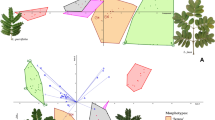Abstract
Two new closely related methods for the determination of the minimal area of phytocenoses are proposed. These methods check and complete each other and consist in determination of the rooted frequency of species in a set of successively enlarged sample plots and calculation of either (I) the mean floristic similarity or of (2) the corrected homogeneity-coefficient for each set of frequency plots of a certain size. The plotting of the above values against the plot size shows that both the mean floristic similarity and the homogeneity-coefficient stop rising at a certain size of the plot, which corresponds to the minimal area. Further enlargement of the frequency plots causes dropping or oscillation of these indices around a certain value.
Similar content being viewed by others
Literature Cited
Balogh, J. (1958): Lebensgemeinschaften der Landtiere.—Berlin et Budapest.
Barkman, J. J. (1968): Das synsystematische Problem der Mikrogesellschaften innerhalb der Biozönosen.—In:Tüxen, R. (ed): Pflanzensoziologische Systematik, Den Haag.
Braun, J. (1913): Die Vegetationsverhältnisse der Schneestufe in den Rätisch-Lepontischen Alpen.—Denkschr. Schwiz. Naturf. Ges., Zürich, 48.
Braun-Blanquet, J. (1964): Pflanzensoziologie. 3. Ed.—Wien et New York.
Braun-Blanquet, J. etJenny, H. (1926): Vegetationsentwicklung und Bodenbildung in der alpinen Stufe der Zentralalpen (Klimaxgebiet desCaricion curvulae).—Denkschr. Schweiz. Naturf. Ges., Zürich, 63: 183–349.
Cain, S. A. (1938): The species-area curve.—Amer. Midland Naturalist, Notre Dame (Indiana), 9: 573–581.
Cain, S. A. etde Oliveira Castro, G. M. (1959): Manual of vegetation analysis.—New York.
Češka, A. (1966): Estimation of the mean floristic similarity between and within sets of vegetational relevés.—Folia Geobot. Phytotax., Praha, 1: 93–100.
Chouard, P. (1932): Associations végétales des forêts de la vallée de l'Apance (Haute-Marne).— Bull. Soc. Bot. France, Paris, 79: 617–634.
Du Rietz, G. E., Fries, T. C. E., Osvald, H. etTengwall, T. Å. (1920): Gesetze der Konstitution natürlicher Pflanzengesellschaften.—Vetenskapliga Och Praktiska Undersökningar i Lappland. Flora Och Fauna, Uppsala et Stockholm, 7: 1–47.
Du Rietz, G. E., Fries, T. C. E. etTengwall, T. Å. (1918). Vorschlag zur Nomenklatur der soziologischen Pflanzengeographie.—Svensk Bot. Tidskr., Uppsala, 12: 145–170.
Ellenberg, H. (1956): Grundlagen der Vegetationsgliederung. I. Aufgaben und Methoden der Vegetationskunde.—In:Walter, H.: Einführung in die Phytologie. 4, Stuttgart.
Gleason, H. A. (1922): On the relation between species and area.—Ecol., Brooklyn, N. Y., 3: 158–162.
Goodall, D. W. (1952): Quantitative aspects of plant distribution.—Biol. Reviews, Cambridge Philos. Soc., Cambridge, 27: 194–245.
Goodall, D. W. (1954): Minimal area: a new approach.—Huit. Congr. Int. Bot. Paris, Rapports Commun. Sect. 7 et 8: 19–21.
Goodall, D. W. (1961): Objective methods for the classification of vegetation. IV. Pattern and minimal area.—Austral. Journ. Bot., Melbourne, 9: 162–193.
Gounot, M. (1961): Les méthodes d'inventaire de la végétation.—Bull. Serv. Carte Phytogeogr., Sér. B, Carte Groupem. Végét., Paris, 6: 7–73.
Gounot, M. (1969): Méthodes d'étude quantitative de la végétation.—Paris.
Gounot, M. etCalléja, M. (1962): Coefficient de communauté, homogénéité et aire minimale. In:Calléja, M., Dagnelie, P. etGounot, M.: Etude statistique d'une pelouse àBrachypodium ramosum.—Bull. Serv. Carte Phytogeogr., Sér. B, Carte Groupem. Végét., Paris, 7: 181–200.
Greig-Smith, P. (1964): Quantitative plant ecology. 2. Ed.—London.
Hopkins, B. (1957): The concept of minimal area.—Journ. Ecol. Oxford, 45: 441–449.
Kershaw, K. A. (1964): Quantitative and dynamic ecology.—London.
Maarel van der, E. (1970): Vegetationsstruktur und Minimum-Areal in einem Dünen-Trockenrasen. —In:Tüxen, R. (ed.): Gesellschaftsmorphologie. Den Haag.
Meijer Drees, E. (1954): The minimum area in tropical rain forest with special reference to some types in Bangka (Indonesia).—Vegetatio, Den Haag, 5–6: 517–523.
Moravec, J. (1971): A simple method for estimating homotoneity of sets of phytosociological relevés.—Folia Geobot. Phytotax., Praha, 6: 147–170.
Sørensen, T. (1948): A method for establishing groups of equal amplitude in plant sociology based on similarity of species content and its application to analyses of the vegetation on Danish commons.—K. Danske Vidensk. Selsk., Biol. Skr., København, 5/4: 1–34.
Tüxen, R. (1970): Bibliographie zum Problem des Minimi-Areals und der Art-Areal-Kurve.— Excerpta Bot., Sect. B, Stuttgart, 10: 291–314.
Werger, M. J. A. (1972): Species-area relationship and plot size: with some examples from South African vegetation.—Bothalia, Pretoria, 10: 583–594.
Author information
Authors and Affiliations
Rights and permissions
About this article
Cite this article
Moravec, J. The determination of the minimal area of phytocenoses. Folia geobot. phytotax. 8, 23–47 (1973). https://doi.org/10.1007/BF02854682
Received:
Published:
Issue Date:
DOI: https://doi.org/10.1007/BF02854682




